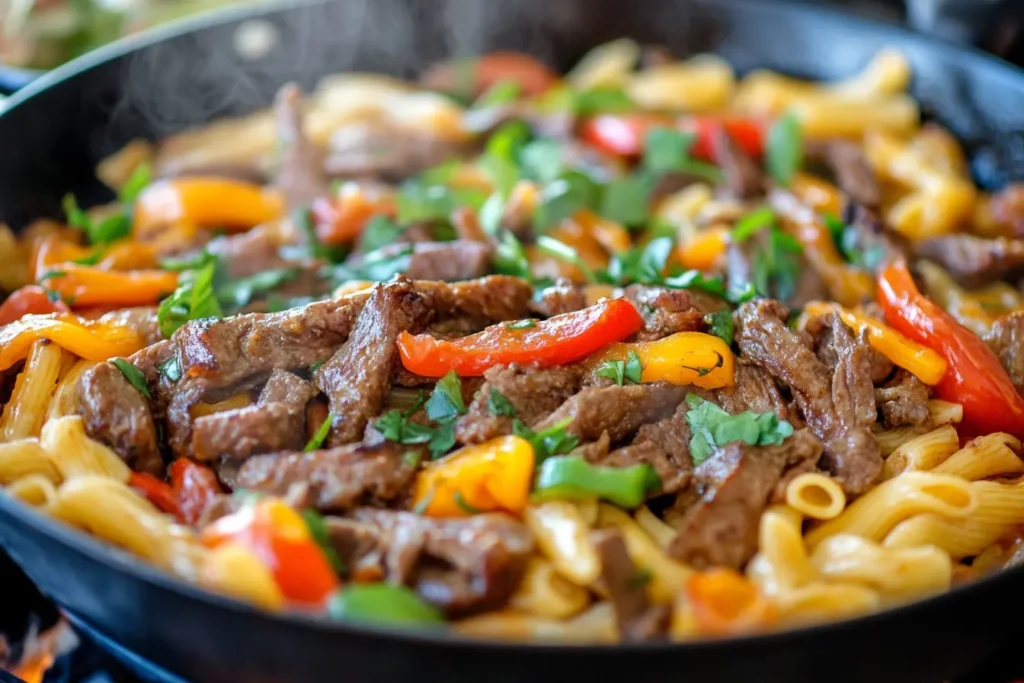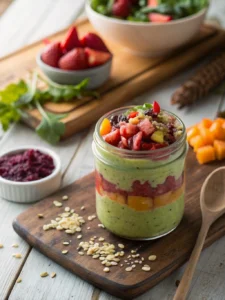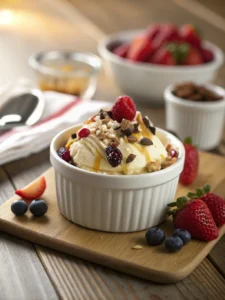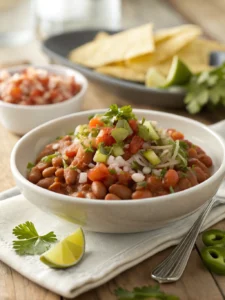Ever wonder what happens when a Philly cheesesteak sandwich meets pasta? Imagine tender steak, caramelized onions, and vibrant bell peppers smothered in gooey cheese. All in one skillet. This recipe turns a classic sandwich into a hearty, hands-off meal ready in under 30 minutes.
This dish is more than just a twist on tradition. It’s a flavor explosion that blends savory, salty, and cheesy notes. It’s perfect for weeknights.
If you’re a philly cheesesteak pasta skeptic or a comfort food lover, this recipe is for you. It combines the hearty fillings of a street cart favorite with the comforting simplicity of a one-pan dinner. No grilling, no complicated layers—just everything you love about Philly’s iconic sandwich, transformed into a dish you can whip up anytime.
Key Takeaways
- Blends philly cheesesteak flavors with pasta for a new comfort food classic.
- Features thinly sliced steak, bell peppers, onions, and melty cheese in one skillet.
- Ready in under 30 minutes, ideal for busy weeknights.
- Perfect for fans of bold, savory flavors and creamy textures.
- Showcases how classic dishes can reinvented as easy, family-friendly meals.
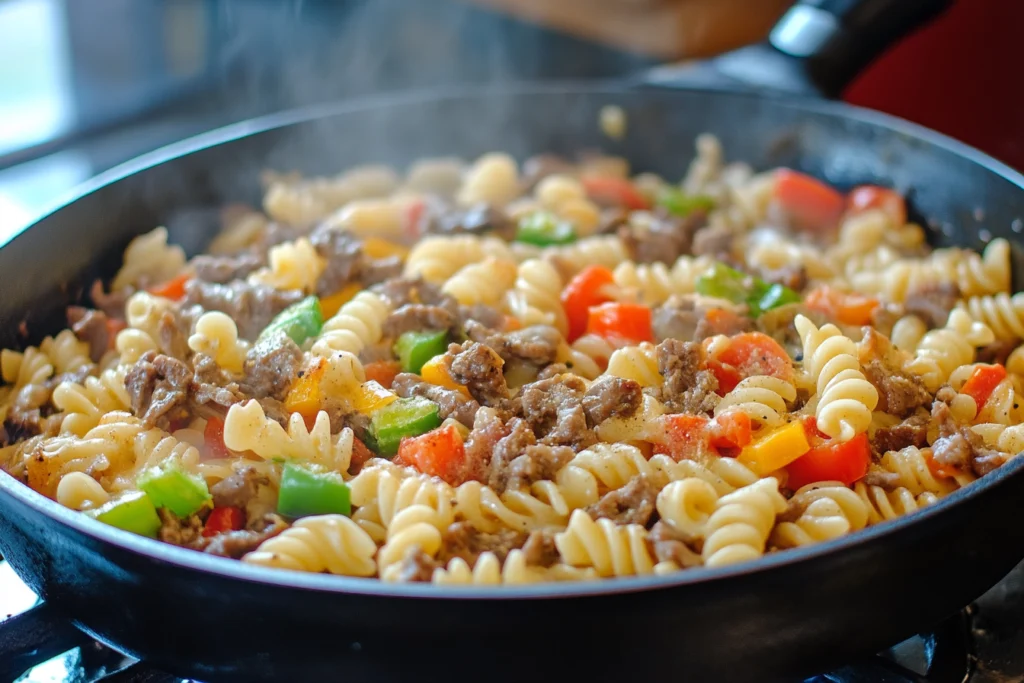
Introduction to Philly Cheesesteak Pasta
Philly cheesesteak pasta combines the flavors of Philly with the comfort of pasta. It comes from the famous cheesesteak sandwich, which started in 1930s Philadelphia. Let’s see how this dish became a new twist in cooking.
The Origin of Philly Cheesesteak
The cheesesteak’s story begins with Pat and Harry Olivieri in the 1930s. The original has thinly sliced steak, melted cheese, and onions on a long roll. It’s made with ribeye and Cheez Whiz, which are key to its taste.
This sandwich’s bold flavors led to the creation of pasta versions. It mixes street food with a satisfying meal.
Why This Pasta Fusion Works
Pasta is the main attraction in philly steak pasta. Here’s why it’s a hit:
- Steak juices mix with pasta, adding deep flavors.
- Cheese turns into a creamy sauce, covering every noodle.
- Crispy onions provide a nice crunch against the soft steak and pasta.
What Makes This Recipe Stand Out
Our philly cheese pasta recipe is simple and delicious. It’s cooked in one skillet, making cleanup easy. It combines the bold taste of steak with creamy cheese, staying true to the cheesesteak spirit.
This dish keeps the cheesesteak’s savory taste but is easier to share. It’s perfect for those who love Philly flavors but want a mess-free meal.
Essential Ingredients for Perfect Philly Cheesesteak Pasta
To make philly cheesesteak pasta like the classic sandwich, each ingredient is key. Start with lean beef cuts like ribeye, sirloin, or flank steak. Slice the meat thin against the grain for tenderness. Choose pasta shapes like penne or rotini to hold the savory sauce.
- Protein: Ribeye, sirloin, or flank steak.
- Pasta: Penne, rotini, or farfalle.
- Vegetables: Green bell peppers, yellow onions, mushrooms (optional).
Cheese Options
| Cheese Type | Flavor Profile | Role in Dish |
|---|---|---|
| Provolone | Mild, slightly nutty | Blends well with savory beef |
| American | Smoky, creamy | Creates the signature steak and cheese pasta meltiness |
| Cheez Whiz | Sweet, tangy | Adds a retro, iconic texture |
For the base, use garlic, Worcestershire sauce, beef broth, olive oil, and butter. Salt and pepper balance the flavors. Adding cream cheese or heavy cream makes it creamier. Fresh vegetables add brightness.
Substitutions: Use chicken breast if avoiding beef, or mozzarella if avoiding processed cheese. Always check labels for gluten-free pasta options.
Kitchen Equipment You’ll Need
Mastering the philly cheesesteak pasta skillet starts with the right tools. Let’s break down what ensures a flawless dish:
Recommended Skillet Types
A sturdy skillet is your foundation. Choose from these options:
- Cast iron skillet: Ideal for searing steak and retaining heat. Its weight prevents burning, but clean gently to avoid rust.
- Stainless steel skillet: Offers even heating and durability. Use medium heat to avoid hot spots.
- Non-stick skillet: Great for beginners, but avoid high heat to protect the coating.
“A cast iron skillet’s grip on heat makes it a pro’s pick for the philly cheesesteak pasta skillet,” says Chef Marco Rivera.
Other Helpful Tools
Complete your setup with these essentials:
- Sharp chef’s knife: Slice steak thinly—try freezing meat 15 minutes for easier cutting.
- Sturdy cutting board: Look for one with juice grooves to catch drips.
- Wooden spoon/spatula: Stir without scratching your skillet.
- Tongs: Perfect for flipping steak without tearing.
- Meat thermometer (optional): Ensure steak reaches 145°F (medium rare).
Don’t worry if you lack specialty gear—most tools are standard in most kitchens. The philly cheesesteak pasta skillet stays accessible no matter your setup.
Step-by-Step Philly Cheesesteak Pasta Recipe
Turn simple ingredients into a delicious philly cheesesteak pasta. Follow these steps to get the perfect mix of flavors and textures.
Preparing the Steak
Cut steak into thin strips against the grain. Sprinkle with salt, black pepper, and a bit of garlic powder. Heat a skillet over medium-high heat—add oil, then cook steak in batches to avoid crowding. Cook until browned, about 3-4 minutes per side. Remove and set aside.
Sautéing the Vegetables
- Chop onions and bell peppers into ½-inch pieces.
- Add to the skillet, sauté until onions are translucent (4-5 mins).
- Add mushrooms if using, cook until softened.
Cooking the Pasta
Boil a pot of salted water, cook pasta to al dente (check package time). Subtract 1 minute if finishing in skillet). Drain and set aside. Alternatively, cook pasta directly in the skillet with broth for extra flavor.
Combining All Elements
Return steak to skillet, add cooked pasta. Deglaze with ½ cup beef broth, stirring to coat. Cook 2-3 mins until sauce thickens. Taste and adjust seasoning.
Adding the Cheese Blend
Stir in shredded provolone and cheddar until melted and creamy. Avoid over-stirring to prevent separation. Serve immediately in bowls.
| Step | Action | Key Tip |
|---|---|---|
| Steak Prep | Slice against grain | Ensures tender texture |
| Vegetables | Sauté until caramelized | Add peppers after onions soften |
| Cheese | Mix until glossy | Remove from heat before cheese fully melts |
Pro tip: Let pasta finish cooking in the skillet sauce for deeper flavor in your philly steak pasta.
Customizing Your Steak and Cheese Pasta
Want to make your steak and cheese pasta your own? You can do it without losing its great taste. Try new things like skipping meat, adding more veggies, or a spicy twist. These changes fit right in.
- Protein Switches: Use 8 oz of ground turkey, lean beef, or Beyond Meat crumbles instead of steak. Cook them first, just like the original.
- Vegetable Boost: Stir in ½ cup of spinach, sliced mushrooms, or roasted zucchini with the peppers and onions. Add sun-dried tomatoes for Mediterranean flair.
- Cheese Options: Try a 50/50 mix of provolone and mozzarella for stretchiness. For heat, blend ½ cup pepper jack with cheddar. Dairy-free? Use vegan cheese shreds.
- Flavor Enhancers: Sprinkle red pepper flakes, a dash of hot sauce, or 1 tsp Italian seasoning when tossing ingredients. Add a splash of balsamic glaze before serving.
“A pinch of smoked paprika adds depth without overpowering the dish.” – Chef Maria Lopez, Food Network contributor
Try one change at a time to keep the flavors right. Swap steak for chicken? Cook it for 5-6 minutes to avoid dryness. Toss in artichokes? Drain them first to prevent sogginess. Every bite should be perfect—crispy veggies, melty cheese, and savory protein. Share your favorite twist in the comments!
Nutritional Information and Dietary Considerations
Knowing the nutritional facts of your philly cheese pasta is key to meeting your dietary needs. This part explains the main nutrients and how to make adjustments.
Calorie Breakdown
A typical serving has 600–700 calories. Ground beef and cheese are the biggest calorie and fat sources. Vegetables and pasta add carbs and fiber. Choosing 93% lean beef or low-fat cheese can cut calories by 20% without losing taste.
Making It Healthier
- Switch to whole-grain pasta like Barilla Plus for more fiber and protein.
- Use a non-stick skillet and cooking spray to cut down on fats.
- Add more veggies, like bell peppers or spinach, to balance nutrients.
Dietary Substitutions
Make your philly cheese pasta your own with these changes:
- Gluten-free: Try Jovial gluten-free penne or zucchini ribbons (briefly cooked).
- Dairy-free: Use Daiya cheddar shreds or nutritional yeast for a cheesy flavor without dairy.
- Low-sodium: Use Better Than Bouillon vegetable base and unsalted cheeses.
- Keto: Replace pasta with spiralized zucchini, cooked until tender-crisp.
When swapping ingredients, adjust the seasoning slowly to keep the dish’s rich, savory taste.
Perfect Pairings: What to Serve with Philly Cheese Pasta Skillet
Make your philly cheesesteak pasta even better with the right pairings. These choices balance its bold flavors, making every bite special.
Beverage Recommendations
Choose drinks that match the savory taste of philly cheesesteak pasta. They should highlight its umami notes:
- Medium-bodied wines: A Merlot or Chianti is great, with a bit of acidity to cut through the cheese and steak. Look for bottles under $20 for a good price.
- Amber lagers: Shiner Bock or Sam Adams Boston Lager are good choices. They complement the dish’s smoky flavors well.
- Refreshing non-alcoholic options: Try lemonade with fresh mint or an Italian soda like Jones Soda’s Cream Soda. They offer a nice contrast.
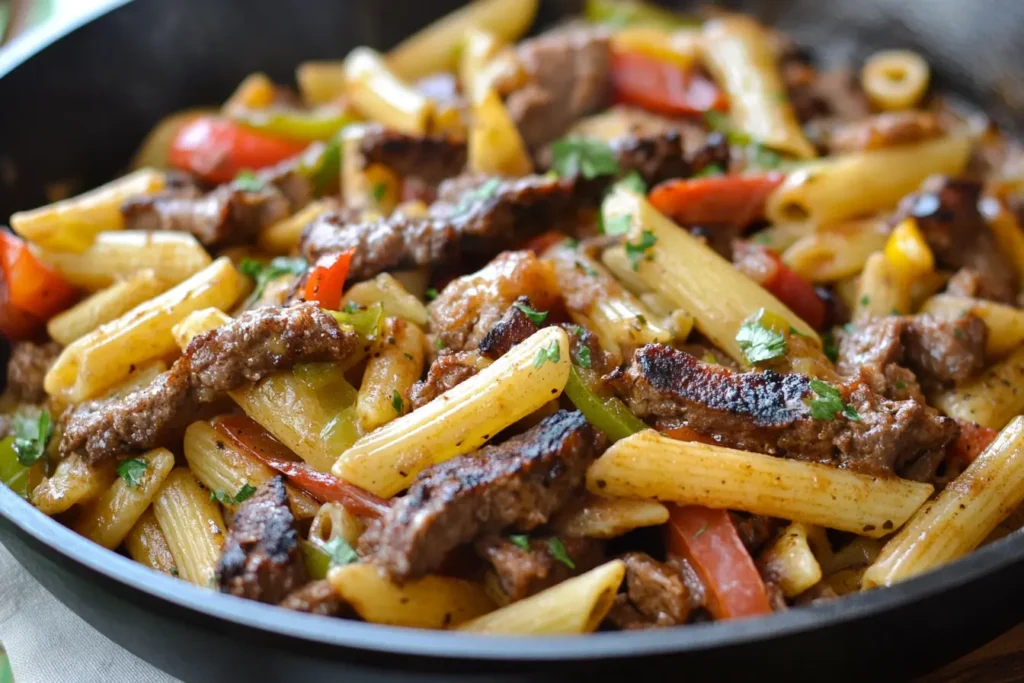
Side Dish Ideas
Balance the rich pasta with light sides that add texture and freshness:
- Herb vinaigrette salad: Mix greens with olive oil, balsamic vinegar, and a bit of garlic powder. Prep time is just 5 minutes.
- Roasted veggies: Toss bell peppers and zucchini with olive oil and paprika. Roast at 400°F for 20-25 minutes.
- Steamed broccoli: Season with lemon zest and parmesan for a quick, healthy option.
Pair with garlic bread for more carbs, but keep pasta servings at 1 cup when adding sides. These pairings make the skillet a complete meal without overpowering its flavors.
Storage and Reheating Tips for Leftover Philly Steak Pasta
Leftover philly steak pasta stays fresh and tasty with the right care. Cool it down to room temperature in two hours to stop bacteria from growing. Store it in airtight containers like glass jars or BPA-free plastic. Use portioned servings for easy reheating.
- Refrigeration: Store leftovers in the fridge at ≤40°F (4°C) for 3-4 days. For freezing, wrap it tightly in parchment paper first, then seal in freezer-safe bags for up to 2 months.
- Freezing Tip: Slightly undercook pasta initially to prevent sogginess when thawing.
Reheat using these methods:
- Microwave: Place in a microwave-safe dish with a damp paper towel over top. Heat at 50% power in 1-minute bursts, stirring between intervals.
- Stovetop: Add a splash of broth or water to a skillet. Simmer over medium-low heat, stirring frequently until heated through (5-7 minutes).
- Oven: Preheat to 350°F (175°C). Bake covered for 10-15 minutes, uncovering last 2 minutes to crisp edges.
Before serving, add fresh herbs or a drizzle of olive oil to revive flavors. Always check the internal temperature reaches 165°F (74°C) when reheating for safety.
Conclusion: Bringing Philadelphia Flavor to Your Dinner Table
The philly cheesesteak pasta skillet is a twist on a classic, ready in under 30 minutes. It’s easy to make in one skillet. The mix of savory steak, gooey cheese, and al dente pasta makes it both familiar and exciting.
It’s perfect for any number of people, and you can add your own touches. Try adding veggies or using gluten-free options.
Thinly sliced steak and sautéed onions are essential for the dish’s texture. You can make it your own by adding peppers or using plant-based options. Each bite honors Philadelphia’s culinary tradition while inviting your creativity.
Share your version online with #PhillyCheesesteakPasta. Join others in reimagining this classic. This recipe is all about your choices and the ingredients. It’s perfect for nights when you want bold flavors without the fuss. Philadelphia’s taste is just a skillet away.
FAQ
What is Philly Cheesesteak Pasta?
Philly cheesesteak pasta is a tasty mix of a Philly cheesesteak sandwich and pasta. It has tender steak, sautéed onions and bell peppers, and creamy cheese sauce. All these ingredients are cooked together in one skillet for a satisfying meal.
Can I use different types of cheese in my Philly steak pasta?
Yes, you can pick your favorite cheese for philly steak pasta! Options include provolone, American cheese, or Cheez Whiz. You can also try mixing cheeses like provolone and mozzarella for extra creaminess or pepper jack for a spicy twist.
What kind of steak works best for this recipe?
Choose tender cuts like ribeye, sirloin, or flank steak for the best philly steak pasta. These cuts are flavorful and tender, especially when sliced thinly against the grain.
Can I make this dish vegetarian or vegan?
Absolutely! Replace the steak with mushrooms, tempeh, or lentils for a vegetarian or vegan version. Use dairy-free cheese and egg-free pasta for a vegan option.
How do I store leftover Philly cheesesteak pasta?
Cool the leftover pasta to room temperature before storing it in an airtight container. It can stay in the fridge for 3-4 days or be frozen for 2-3 months. Freezing slightly undercooked pasta helps it stay fresh.
What are some good side dishes to serve with Philly cheesesteak pasta?
Serve lighter sides with your philly cheesesteak pasta. A simple green salad, roasted vegetables, or garlic bread are great choices. They offer a refreshing contrast to the rich pasta.
Can I add more vegetables to my pasta?
Yes! Adding more veggies like spinach, cherry tomatoes, zucchini, or roasted red peppers can enhance your dish. They add flavor and nutrition.
What beverages pair well with Philly cheesesteak pasta?
Pair your philly cheesesteak pasta with a medium-bodied red wine like Merlot or a refreshing amber beer. Iced tea or lemonade are also good choices to balance the dish’s richness.
How can I make my Philly cheesesteak pasta healthier?
Make your philly cheesesteak pasta healthier by using leaner beef, whole grain pasta, and more veggies. Reducing cheese or using low-fat options can also help without losing flavor.
